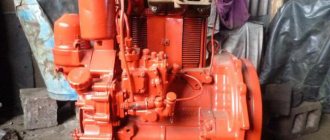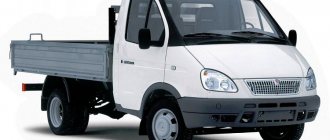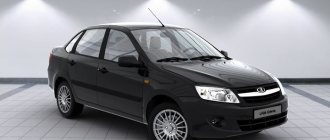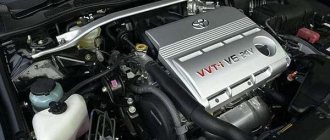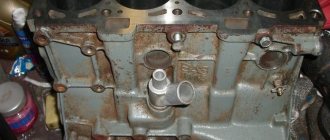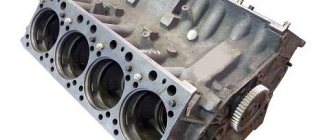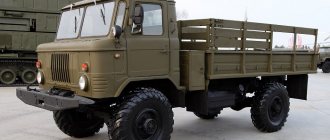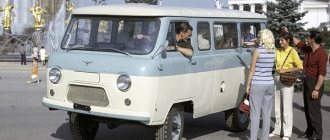Technical characteristics of the VAZ-2109 car
- VAZ-2109 is a front-wheel drive passenger car with a transverse power unit, designed for use on paved roads.
- The body is all-metal, monocoque, five-door, hatchback type.
- The fifth door is located in the rear of the body and is intended for loading luggage.
- To transport large and long cargo, the rear seat can be folded, thereby increasing the volume of the luggage compartment.
Engines are four-cylinder carburetor, with a displacement of 1.1, 1.3 and 1.5 liters. Since 1993, some cars have been equipped with various fuel injection systems.
- Thanks to the front-wheel drive layout, the car has improved handling characteristics compared to rear-wheel drive VAZ models, especially on slippery roads and when cornering.
- Bottom view of a VAZ-2109 car
- It is possible to equip it with hydraulic headlight leveling, electrically heated front seats, electric windows, an on-board computer and a catalytic converter for exhaust gases in the exhaust system.
- Specifications
| Index | VAZ-2109 | VAZ-21091 | VAZ-21093 |
| Total information | |||
| Number of places | 5 | ||
| Number of seats with rear seat folded | 2 | ||
| Useful weight, kg | 425 | ||
| Weight of transported cargo, kg: | |||
| with one passenger | 275 | ||
| for four passengers | 50 | ||
| Vehicle curb weight, kg | 945 | ||
| Turning radius on the outer wheel track, m | 5,2 | ||
| Maximum speed, km/h | 148 | 140 | 156 |
| Acceleration time from standstill with driver and passenger to 100 km/h, s | 16 | 17 | 13 |
- Braking distance of a vehicle with full weight from a speed of 80 km/h on a horizontal section of a dry, level asphalt highway, m, no more than:
- - when using the service brake system - 38;
- - in case of emergency operation (only one of the circuits) - 85.
- Engine
| Model | 2108 | 21081 | 21083 |
| Type | Four-stroke petrol carburetor | ||
| Number and arrangement of cylinders | 4 in a row | ||
| Bore x stroke, mm | 76×71 | 76×60,6 | 82×71 |
| Working volume, l | 1,3 | 1,1 | 1,5 |
| Compression ratio | 9,9 | 9,0 | 9,9 |
according to GOST 14846–81 (net), kW (hp) | 46,6 (63,4) | 39,9 (54,3) | 51,5 (70,0) |
| 94,8 (9,66) | 77,9 (7,94) | 106,4 (10,85) |
| Crankshaft rotation speed at maximum torque, min –1 | 3400 | 3600 | 3400 |
| Cylinder operating order | 1–3–4–2 |
- Transmission
- Clutch - single disc, dry with central diaphragm spring
- Clutch release drive - cable-type, backlash-free
| |||
| Car model | VAZ-2109 | VAZ-21091 | VAZ-21093 |
| 1st gear | 3,636 | ||
| 2nd gear | 1,95 | ||
| 3rd gear | 1,357 | ||
| 4th gear | 0,941 | ||
| 5th gear | 0,784 | ||
| reverse | 3,53 | ||
| main gear | 3,9 | 4,13 | 3.7 or 3.9 |
| Front wheel drive: external and internal constant velocity joints connected by shafts |
Chassis
| Front suspension | independent, with telescopic hydraulic shock absorbers, coil springs, lower wishbones with braces and anti-roll bar (MacPherson) |
| Rear suspension | with coil springs, double-acting hydraulic shock absorbers and trailing arms elastically connected by a transverse beam |
| Wheels | disk, stamped |
| Rim size | 4 ½ –13, or 4 ½ –13H2 (for tubeless tyres), or 5J–13H2 (for tubeless tyres) |
| Tires | radial, tubed or tubeless |
| Tire size | 165/70 R13 (165/70 SR13 - imported), 175/70 R13, 185/70 R13 |
- Steering:
- Steering type - safety
- Steering mechanism - rack and pinion
- Steering - two rods with rubber-metal joints on the steering mechanism side and ball joints on the swing arm side
Towards the end of the 1980s, AVTOVAZ decided to fill the empty niche of comfortable and versatile family models with the VAZ-2109 car. The fact that the debut domestic mass-produced front-wheel drive car appeared at the Volga Automobile Plant was a significant event not only for the Volga residents, but also for the entire Soviet automobile industry.
It’s a little symbolic, but the start of production of the G8 coincided with a significant event that was celebrated in the fall of 1984 - the 60th anniversary of the automobile industry of the Union of Soviet Socialist Republics. After two years, the original assembly line of the car plant in Togliatti produced a pilot batch of 159 Nine models.
The new version of the “chisel” inherited all the technical innovations from the older model and was able to instantly gain the respect of car lovers. Among all the points, the most important was the “rational” number of doors. However, despite this, a three-door version entered mass production. The logical question arises, why?
Because in a state where personal transport was considered a luxury, and happy car owners felt the transport difficulties of their relatives and friends, the standard 3-volume sedan version was more suitable to the needs of drivers. For a long time, all Soviet mass-produced cars were produced in just such a body.
More productive station wagons, which were produced in small quantities, began to be sold only towards the end of the 1960s, and they were considered in great short supply. There was not a word about other versions of the body: directors of automobile enterprises did not even risk conducting experiments, objectively believing that these programs would not be positively received “at the top.”
But in the case of the G8, everything turned out in the opposite order. At the end of the 1970s, all of Europe was literally overwhelmed by the fashion for hatchbacks. The leaders of the Tolyatti automobile plant, wanting to comply with modern trends, during the design of the new model series, decided to introduce into it, in addition to the standard sedan, 3- and 5-door hatchbacks that were fundamentally fresh for Soviet industrial turnover.
The entry into the foreign market of a new car, designed in accordance with the standards of global trends, was supposed to strengthen VAZ's export positions. The Ministry of Automotive Industry cooled down the ardor of the engineers from Tolyatti a little, calculating the impossibility of financing the production of all 3 versions for assembly line assembly.
In reality, it was possible to free only one line of the factory conveyor for the assembly of 2 standardized modifications. As it turned out, the role of those “lucky ones” was a hatchback, which had a lot of common body elements. As the base version, they decided to choose a cheaper three-door car, and a couple of years later, a five-door car “came to the rescue.”
The sedan version (VAZ-21099) was introduced into mass production only at the end of 1990. Although this delay in a sense benefited the enterprise itself, since with the appearance of the sedan there would have been intense competition with the hatchback version, which was in no way included in the plans of the management of the Volzhsky Automobile Plant.
Weight of VAZ-2109
For most modifications of the VAZ-2109 hatchback, the weight with all the regulatory equipment, a filled fuel tank and a driver in the cabin varies from 915 kg to 945 kg.
Model weight:
Curb weight of the VAZ-2109 car:
- Hatchback (1987 – 2006): 915 kg (1340 kg), 945 kg (1370 kg).
- SUV (1997 – 2002): 1240 kg.
The value of the permissible gross vehicle weight is indicated in parentheses.
Model information:
A front-wheel drive small class II car with a hatchback or SUV body was produced by the Russian company AvtoVAZ from 1987 to 2006, the model from 2004 to 2011 was assembled in Ukraine at the ZAZ plant, the body is equipped with 5 doors, 5 seats.
Important: taking into account the provisions of GOST R 52389-2005, when calculating the curb weight of the vehicle, the driver’s weight is also taken into account, the value of which is conventionally assumed to be 75 kg.
Other names:
Other designations of the VAZ 2109 hatchback on the Russian market: VAZ 2108, VAZ 2113, VAZ 2114, Lada Samara.
Years of production: years of production of all modifications of the model: 1987-2014.
| Total weight of the VAZ 2109 car | |||
| Drawing Drawing of a car | Weight min (kg) Minimum vehicle weight for different modifications of VAZ 2109 | ||
Data are presented in millimeters (kg)
| Weight max (kg) Maximum vehicle weight for different modifications Data are presented in millimeters (kg) | Modifications Number of modifications of the model in our database | ||
| 915 (kg) | 985 (kg) | 4 |
| Weight of car VAZ 2109 | |
| Parameter Vehicle Parameter | |
Caution: the above data are official figures from manufacturers, however, please note that the information is for reference only and does not guarantee absolute accuracy.
Description
The technical characteristics at that time were standard: a 1.1-liter engine, a carburetor in the mechanisms, a maximum power of 54 horsepower.
After some time, models of this car with an improved engine began to appear on sale.
The main changes include a larger engine volume, increased to 1.5 liters, and an engine temperature sensor, and in the early 2000s, models with an injector entered mass production.
It is also possible to perform engine tuning in the VAZ 2109, which allows you to obtain improved performance for relatively little waste.
The main advantage of this machine was its fairly cheap maintenance, which was typical for any of the production machines.
Even after the end of the warranty period, keeping the car in good condition was quite simple and did not require any special expenses, the main thing was to change the oil regularly. And thanks to the prevalence of this range of models, it is quite easy to find replacement parts for broken ones both in car repair shops and in the hands of motorists.
Almost any driver can do all the work with his own hands. That is why most owners of this car want to drive this model, which is cheap both to repair and to operate, for as long as possible. Tuning the VAZ 2109 engine is also easy.
Malfunctions
- The engine does not start. There is no fuel supplied to the carburetor or not enough fuel is supplied. The following problems may be causing this problem:
Causes How to fix the problem
| Foreign objects and debris got into the fuel line, which led to severe blockage. The fuel pump, carburetor filter, fuel line may be clogged. | Carry out a complete cleaning of the fuel supply systems to the engine. This can be done either with water pressure or with compressed air. |
| Failure of the pump supplying fuel to the engine. | Conduct a full diagnostics of the pump, identify the breakdown, and replace the faulty part with a working one. |
| Foreign objects or debris have entered the fuel filter. | Cleaning the filter yourself is quite difficult and time-consuming. It is much cheaper and faster to replace it with a new one. |
| Ignition problems. The engine starts poorly or does not start at all. | Conduct diagnostics of the ignition system, seek help from specialists. Partial or complete disassembly of the VAZ 2109 engine may help find the fault. |
- Problems and malfunctions during operation of the solenoid valve. This part is part of the carburetor and affects the ignition process, which is why its breakdown leads to the following troubles
Causes How to fix the problem
| Broken or damaged wiring. This problem affects the operation of the valve control unit, which leads to faulty fuel supply and reduces the power of the VAZ 2109 engine. | Carry out a full check of each circuit, find the damaged wire, replace it with a intact one, and check the operation of the system. |
| The solenoid valve control unit does not work. | In this case, replacing or repairing it yourself is risky due to the complex structure of the device. It is advisable to entrust repairs to specialists. |
| During the initial operating cycle of the engine, the carburetor air damper does not operate, which should open at the first flashes in the engine cylinders. | The cause of this breakdown may be depressurization of the starting device in the carburetor. |
- Engine problems
Causes How to fix the problem
| The idle speed of the engine is difficult to adjust and does not work properly. The engine is breathing. | In this case, you will need to carry out a complete setup and adjustment of the idle speed. Disassembling the VAZ 2109 engine also helps to identify the fault. |
| The system responsible for controlling the carburetor solenoid valve is faulty or partially broken. | Carry out a full check of each circuit, find the damaged wire, replace it with a intact one, and check the operation of the system. |
- Problems in the operation of the VAZ 2109 carburetor engine
| Causes | How to fix the problem |
| The carburetor does not work due to severe contamination of the channels or jet. | The mentioned parts of the carburetor are cleaned using compressed air. It is important to control the air supply to prevent damage. |
| Liquid has entered the carburetor or jet. | Also, use compressed air to clean carburetor systems from residual liquid. Check the fuel tank for sediment and drain if necessary. |
| The starting device does not work due to depressurization of the system. The trigger diaphragm is broken. This may reduce the productivity of the VAZ 2109 engine. | Check for damage to the diaphragm, replace if a malfunction is detected. |
| Problems with the ignition system. Complete or partial inoperability. | Carrying out diagnostics of the ignition system, replacing faulty parts with new ones. |
| Air entering the brake booster compartment. This usually happens due to a torn vacuum hose. Such a breakdown affects the performance of the econometer, ignition distributor and vacuum regulator-sensor. | Check the hose, find damage and repair it. You can also completely replace the hose. It is necessary to pay attention to the mounting clamps; if necessary, they should be tightened. |
| Damage to the gasket in the intake manifold connections. Such a breakdown leads to air leaks into the intake manifold. Affects the performance of the carburetor and engine of the VAZ 2109. | Check for damage to the intake pipe. Tighten all nuts. If this does not help, then most likely you will need to replace the gaskets with new ones. |
Tuning
Since the characteristics of this brand of car are far from the highest compared to modern automotive technology, you may want to tune the VAZ 2109 engine.
This will significantly increase engine power and improve performance characteristics.
The VAZ 21093 engine, the injector of which is one of the weakest components in the entire car, can be subject to some improvements regarding the shape and diameter of the exhaust and intake channels. You can also change the shape of the combustion chamber and valves, which will subsequently lead to a reduction in fuel consumption during intensive driving.
Some may be wondering: “what engine can be installed on the VAZ 2109.” But it is worth remembering that such a solution is quite expensive. Tuning a VAZ 21093 engine is much cheaper and faster than completely changing the engine.
To improve the performance of the machine, you can replace the camshaft with another one that has extended valve timing. The performance of the machine is also affected by how much engine oil is used and what type of lubricant is selected. By purchasing an improved lubricant, the operation of the machine is significantly improved.
Engine for a VAZ 2109 car: characteristics, repair and tuning Link to main publication
Weight of VAZ 2109 injector
This is such a nuisance: The car itself accelerates at 20 until it warms up! as if someone is sitting and accelerating! The on-board vehicle clearly shows that the TPS at idling is 0%, but at the engine temperature from +20 to somewhere around +50 degrees, the readings periodically jump to 2-3%. Often rises to 5-9%! Why don't I press the pedal?
With such jumps in the throttle position, the speed and ignition angle rise. I tried to change the sensor itself - no result, i.e. same bug. If you disconnect the connector from the sensor, the indicator freezes by 20% and the speed does not change... If you disconnect the IAC, the speed still jumps.
Here is a possible cause of the problem: The bolt that secured the end of the ground wire from the injection wiring is loose.
As it turned out, the thread was torn off. I had to screw the mass to another place. Time will tell whether this was the cause of the problem...
A little time passed, the engine cooled down and I tried to start and warm up the engine... Everything was the same... it means that wire is not the reason. I move the bundle of wires in the area where it lies on the thermostat - the motor starts to work intermittently.
I solder the twists and look for where there was an obvious jamb.
There was only one suspicion that the ground tip of the second ground wire had been crimped, there was a thick power wire and a thin one stretching from the ignition module connector...
Now everything seems to be working and not buggy! I only soldered the ground wire terminal. At the same time, while the wiring was disassembled, I took apart the twists in the harness for the injectors, put on heat shrink, twisted and soldered. Then I insulated the solder joints with heat shrink. The wiring was originally for an eight-valve engine; when switching to 16 valves, the wiring harness for the injectors had to be extended.
Most likely it was the tip of the mass wires...
As you know, on VAZ 2108, 2109, 21099 cars the electrical equipment is made according to a single-wire circuit. The function of the negative (“mass”) wire is performed by the car body and engine. Therefore, the negative terminals of all electrical appliances (electricity sources and consumers) are connected to the body or engine.
Features of fastening the “ground” of electrical equipment of VAZ 2108, 2109, 21099 cars
— Connection “negative battery terminal – engine and car body”
The negative thick wire (usually black) goes from the negative terminal of the battery to the gearbox housing (see photo above). Another thick wire (most often the so-called “braided wire”) from the same negative terminal goes to the body and is attached to a stud next to the battery. This connection ensures the presence of a “minus” from the battery terminal on all electrical devices after turning the key in the ignition and ensures normal operation of the starter (stable engine starting).
— Connection “generator – engine”
This is ensured by the location of the generator directly on the engine, which is constructive for VAZ 2108, 2109, 21099. After starting the engine and turning on the generator, the “minus” and “plus” of the car’s electrical equipment will now be tied to it, and not to the battery.
Malfunctions of the “mass” of electrical equipment of cars
There are usually only two ground faults:
— poor (oxidized) contact at the connection points;
- “break” in the wires.
If there is poor contact with ground, problems with starting the engine are possible (the retractor relay clicks, the starter does not turn). In such a situation, many begin to repair or change the starter, although it is only necessary to clean the contact points of the ground wire to the engine and body or the negative terminal with the output to the battery.
In addition, reliable ground contact is important for the normal operation of electrical consumers on a car (headlights, heater, wipers, etc.). For example, so-called “wandering” malfunctions or “glitches” often occur, when the device sometimes works, sometimes doesn’t, and then works again. In such a situation, it is necessary, first of all, to put in order the main “mass” wires coming from the battery terminal, and secondly, to check the reliability of the connection of the “negative” wire going from each device to the minus (usually the black wire).
A “break” in the wires can occur when the “mass” wire is broken or is severely oxidized at the point of attachment to the “negative” terminal of the battery.
— In addition to checking the “negative” connections of the electrical equipment of VAZ 2108, 2109, 21099 cars, in case of problems with starting the engine or operating electrical appliances, it is also necessary to measure the voltage at the terminals of the battery in order to assess the degree of its performance. Its malfunction or low charge level can cause the ground-related malfunctions described above.
More articles on electrical equipment of VAZ 2108, 2109, 21099 cars
Performance characteristics of the VAZ 2109 nine
Maximum speed: 160 km/h Acceleration time to 100 km/h: 13 sec Fuel consumption per 100 km in the city: 10 l Fuel consumption per 100 km on the highway: 5.7 l Fuel consumption per 100 km in the combined cycle: 7.3 l Fuel tank volume: 43 l Vehicle curb weight: 945 kg Permissible gross weight: 1370 kg Tire size: 165/70 SR13
Engine characteristics
Location: front, transverse Engine capacity: 1500 cm3 Engine power: 78 hp Number of revolutions: 5400 Torque: 115/3000 N*m Power system: Distributed injection Turbocharging: no Gas distribution mechanism: OHC Cylinder arrangement: In-line Number of cylinders: 4 Cylinder diameter: 82 mm Piston stroke: 71 mm Compression ratio: 9.9 Number of valves per cylinder: 2 Recommended fuel: AI-95
Brake system
Front brakes: Disc Rear brakes: Drum
Steering
Steering Type: Rack and Pinion Power Steering: No
Transmission
Drive: Front Number of gears: manual gearbox - 5 Gear ratio of the main pair: 3.9
Suspension
Front suspension: Shock absorber Rear suspension: Coil spring
Body
Body type: hatchback Number of doors: 5 Number of seats: 5 Vehicle length: 4006 mm Vehicle width: 1650 mm Vehicle height 1402 mm Wheelbase: 2460 mm Front track: 1400 mm Rear track: 1370 mm Ground clearance (clearance): 160 mm Maximum trunk volume: 1000 l Minimum trunk volume: 270 l
Production
Year of manufacture: from 1987 to 2006
Appearance
From the outside, the VAZ-2109 is an evolution of the Soviet car. Here you can notice the transition to rectangular body lines, which are clearly distinguished by the bow headlights, which are shaped like a trapezoid, as well as a flat-shaped radiator grille and a slightly inclined hood. It was decided to place the turn signal lights on the long front fenders.
After some time, hydraulic headlight range control began to be installed on all “nines”, and some vehicles had a brush headlight cleaner. In 1989, the debut restyling of the “nine” exterior took place, which consisted of a transition from small front wings to longer ones. The most dubious component in the exterior of the G8 and VAZ-2109 was the so-called nasal mask.
It was a fairly complex type of body part, which was adjacent to the hood and wings installed in front. The combined mask area had a beak that protruded forward of the radiator trim. Block headlights were installed on the sides of this unusual structure. Such a pile of elements reduced the already slight elegance of the Soviet car, and the clear lines connecting the cladding to the wings looked unpleasant.
We decided to use only a solid wing, without any “tricks,” which improved the appearance of the VAZ 2109. After this, they installed a new grille, which had two longitudinal stripes in a large frame. After some time, they began to use a new version, consisting of 3 massive stripes, devoid of any frame.
VAZ-2109 with an updated radiator grille
The side part has the same straight lines of doors and roof, wheel arches and average ground clearance. “Nine” is very similar to its predecessor, the VAZ-2108, which was nicknamed “chisel”. The Soviet hatchback has the same nose shape. Unusually large doors and a thick central pillar add “sporty features” to the model.
On the “nine”, the width of the doors installed in front was reduced from 1,264 to 1,025 millimeters. Thanks to this, the design team was able to incorporate rear doors into the side of the body, the width of which is 885 millimeters. The rectangular rear lights are limited by the line of the luggage compartment lid, which also has a sharp transition at an angle to the roof.
The fifth door received a rear window with a wiper, and the bumpers, along with the side skirts, were made of black plastic (there is a similar bumper in front). The design of the VAZ 2109 has a certain swiftness of lines, but it is very far from a sports car.
Here the developers placed great emphasis on the more practical aspects of the vehicle. When 1987 arrived, the new model mastered the production of plastic gas tanks, which were much lighter and easier to assemble than others. VAZ-2108 and VAZ-2109 already had gas tanks made of steel and plastic.
Interior
The interior decoration of the VAZ is reminiscent of the minimalism of the 1980s. The instrument panel and dashboard create an almost right angle. There are only 3 types of panels: “low”, “high” and “European”. If we talk about the quality of the plastic used as finishing, then it is far from ideal.
Of course, by installing plastic in the interior of the Nine, it was possible to reduce the weight of the car, but on the other hand, it deprived VAZ cars of that touch of luxury that the Zhiguli of the classic division is remembered for. If you look at it differently, the ergonomic level is not bad, so you don’t have to be distracted from driving the vehicle on the road.
This was partly achieved through the compact arrangement of controls. Inside the steering wheel there is one curved cross member with a horn button. Airbags are not provided by the factory. In general, the interior of the VAZ-2109 is purely practical with claims to the level of comfort.
Despite the laconic “low” instrument panel, it is quite comfortable. Although many liked the high panel 2109. The seats installed in front received headrests. In addition, the front seats have upper seat belt attachment points that are height adjustable.
The elastic seats provide good body support. But a tall driver will lack the choice of adjusting his seat in the longitudinal plane. The rear sofa, although designed for three passengers, can only accommodate two people comfortably.
Do not forget that their height should be no more than 175 cm. The luggage compartment volume of the Soviet hatchback is quite modest 270 liters of usable space (the more practical platform version already received 400 liters).
Price and options
The “nine” did not have a special level of comfort, so there is simply nothing to describe to a greater extent. Even then, it was in many ways superior to foreign cars. But the domestic hatchback was distinguished by its maintainability and the presence of the necessary parts.
The steering wheel did not have a hydraulic booster, so you had to physically work hard. There was a standard heater, a simple steering wheel and standard seats with seat belts installed.
It was possible to adjust the external mirrors from the interior using a mechanical lever. Today, the VAZ 2109 can only be purchased on the secondary market. Usually the price tag for this car is low, so you can buy a car on the go from 60,000 rubles.
Tuning
Since the characteristics of this brand of car are far from the highest compared to modern automotive technology, you may want to tune the VAZ 2109 engine.
This will significantly increase engine power and improve performance characteristics.
The VAZ 21093 engine, the injector of which is one of the weakest components in the entire car, can be subject to some improvements regarding the shape and diameter of the exhaust and intake channels. You can also change the shape of the combustion chamber and valves, which will subsequently lead to a reduction in fuel consumption during intensive driving.
Some may be wondering: “what engine can be installed on the VAZ 2109.” But it is worth remembering that such a solution is quite expensive. Tuning a VAZ 21093 engine is much cheaper and faster than completely changing the engine.
To improve the performance of the machine, you can replace the camshaft with another one that has extended valve timing. The performance of the machine is also affected by how much engine oil is used and what type of lubricant is selected. By purchasing an improved lubricant, the operation of the machine is significantly improved.
Owner reviews
Despite the rather outdated model, appearance and low dynamic performance, as well as the low level of comfort, many motorists speak quite well about the “chisel”. I am pleased with the simplicity and inexpensive maintenance. Parts can be purchased for the best possible price, and also at a flea market. You can repair it yourself. The car is ideal for tuning.
The unpretentiousness of the car is known to many. Positive reviews include fairly acceptable fuel consumption, at the level of 8-10 liters in the combined cycle. Summer residents can especially be pleased with the good ground clearance, which allows them to confidently drive over uneven surfaces and not be afraid of bumpy roads.
It’s bad that there is no hydraulic power steering, so you have to make physical efforts to control the car, especially while standing still. Inside, people can comfortably fit only in the first row of seats. For the second row there is not much free space left in the legs and above the head. It’s not very comfortable for the three of us to sit, and the transmission tunnel running in the center clearly causes discomfort.
According to reviews from VAZ 2109 owners, the hatchback’s heater works strangely; at first the interior is filled with cold air, and only then warm air begins to flow in. The quality of the interior is very mediocre, the plastic is cheap, you can hear crickets everywhere, and there are noticeable large gaps between the panels. The power unit very often lacks power, so you have to spin the engine up to 4,000 rpm.
If desired, it would be possible to install air conditioning, but the engine is very weak, so the question disappears. Safety is also far from ideal, so if there is a serious accident, at best you can get away with injuries. Only recently, domestic cars began to be equipped with many systems that ensure safety, but this, of course, did not affect the VAZ 2109 in any way.
One thought on “Location of components and parts on the injection car VAZ-21099”
I have a fan relay on a 2109 injector, located to the left of the one marked in the photo
How the mass of the ECU and the mass of the engine - body are arranged, where it is located and how to check it. It is these interesting questions that we will address on this page.
The topic is really interesting and not as simple as it seems at first glance.
It would seem that there is nothing complicated here - a simple circuit and a rather thick wire, with which it is unlikely that anything can happen. But not everything is so simple, and we will “talk” about this further.
Advantages and disadvantages
Pros of the car
- Inexpensive Soviet-made car;
- Front-wheel drive can certainly be considered an advantage;
- Acceptable ride height;
- Good dynamics, high speed, pleasant handling and sufficient stability on different surfaces;
- Heating and ventilation cope well with their tasks and supply air to several points at once, which improves the uniform distribution of thermal air throughout the cabin;
- Acceptable fuel consumption;
- Ideal for tuning;
- Availability of spare parts and good maintainability.
Cons of the car
- Corrosion of metal;
- The appearance is clearly not for everyone;
- A small resource of some details;
- Mediocre sound insulation of the cabin;
- Low equipment;
- There is very little free space, especially for rear passengers;
- Small luggage compartment;
- Poor maneuverability;
- Poor quality interior;
- Low level of security;
- The power unit clearly lacks power.
Repair and service
On average, repairs to internal combustion engines of VAZ 2109 modifications are done based on mileage. This figure is about 200,000 km. Engine overhauls are carried out similarly to any Zhiguli power unit. Since, compared to the Volgovsky engine, the Vazovsky is quite small, motorists often do the bulkhead in their garage with their own hands.
The 2109 engine is highly repairable, since the cast iron block is quite difficult to destroy, and the cost of the head is low, which allows you to repair the internal combustion engine cheaply and without much expense with your own hands. Another positive factor in the repair is that the power unit is simple in design and even inexperienced car enthusiasts are able to carry out minor repairs to the VAZ 2109 engine with their own hands.
The main problems that many people face include: changing the oil in the VAZ 2109 engine, replacing spark plugs and high-voltage wires, as well as overhauling and adjusting the carburetor. By the way, almost all engines were equipped with an excellent injection element, which everyone knows as “Solex”.
Another question that car enthusiasts often ask is how much oil should be poured into the engine? This indicator depends on the type of motor. For example, for a VAZ-21081 this will be one indicator, but for a VAZ −11183-20 it will be completely different. Therefore, if a motorist wants to know how much oil is in his power unit, he needs to look at the technical documentation.
